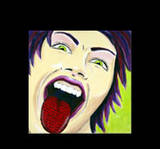 Brooke, from one of the local wineries, says if she hears one more person comment that Walla Walla table reds are made from "leftovers", she is going to SCREAMMM!!! And I happen to AGREE! Like Brooke, I really hate the term "leftovers" regarding the local red table blends. Leftovers seem to have a negative connotation, yet food (and wine) can taste its very best in that form. Haven't you noticed how leftover homemade soups, stews, and spaghetti sauce can taste better a day or two later? Who ever complained over a leftover Thanksgiving turkey sandwich?
Brooke, from one of the local wineries, says if she hears one more person comment that Walla Walla table reds are made from "leftovers", she is going to SCREAMMM!!! And I happen to AGREE! Like Brooke, I really hate the term "leftovers" regarding the local red table blends. Leftovers seem to have a negative connotation, yet food (and wine) can taste its very best in that form. Haven't you noticed how leftover homemade soups, stews, and spaghetti sauce can taste better a day or two later? Who ever complained over a leftover Thanksgiving turkey sandwich?I am always-always telling the Walla Walla wine tourists that some of the tastiest values are Walla Walla's red table blends. The majority of these jewels are under $20 a bottle and while I haven't tried all of them, the ones I have tasted have become repeat performances for me.
So how does a red table blend come together? It all varies on the winemaker and the ultimate goal of the winery, but one thing to remember these wines are not done by accident. These so-called "leftovers" are done on purpose by the winery so they can offer their customers an affordable wine. These table blends are designed for all degrees of customers - - from the frugal, the wine newbie and the wine expert who is looking for an every day wine.
Some wines are used from second pressings and that is not a bad thing. It is usually the pressings of juice that is of a suitably high quality instead of using all free run juice. Think of free-run as the cream off of the top and the second pressing as the milk.
A non-vintage wine is made from the juice of grapes harvested from several years; there is no year noted on the label of such wine. Some of these wines may be the finest in the winery, but not chosen because of volume. It might be too much or not enough wine in volume to fit a specific bottling. Not enough to make a single varietal bottling or these wine may not be what the winemaker is looking for when producing other blends.
Blended wines are no way inferior to single varietal wines. And since many of them are full bodied you can drink them now or put a couple of years on them. Sometimes a red table wine can outshine some of the more expensive blends. I think it is important for wine consumers to understand that as long as a Walla Walla winery's name is on the label, the red table blends will not get any less attention from their winemaker.
For the price and quality the Walla Walla table reds are excellent bargains. These wines are for every day sipping and can be paired with hamburgers, taco wagon faire, and spaghetti Wednesdays. Kick the dining up a notch and serve it with a piece of prime rib or chocolate lava cake with raspberry sauce.
Here is an example of some of the fine table reds produced in the Walla Walla Valley: Bergevin Lane Winery "Calico Red", Forgeron Cellars "Anvil Red", Isenhower Cellars "Wild Thyme", L'Ecole No. 41 "Recess Red" (formerly School House Red), and Waterbrook Winery "Melange."
Also, Woodward Canyon's non-vintage table red is made primarily from grapes from prestigious Washington State Vineyards. It is a terrific buy at $17.00. If you can turn your nose up at Abeja's Beekeeper's Blend priced at $18.00, then you are a true Philistine and not deserving of this elegant blend.
The Wine and Spirits magazine and The Wine Enthusiast recognized Three Rivers Winery "Rivers Run" - 2003 at $13,00 and last but not least, Tamarack Cellars "Firehouse Red" has been noticed by Robert Parker. It was rated 61 in the Wine Spectator's list of top 100 wines in the world for 2004. In fact, I am taking a bottle of Fire House Red camping with me this weekend.
Now I ask you - - does a wine like Tamarack's "Firehouse Red" appear to be mere leftover to you?
1 comment:
Thank you Catie!!! Your rant and rave was perfectly phrased and said everything and more!!! In fact the next time I get someone in turning their nose up at RTW I'm going to print this blog and staple it to their forehead!!!!
Okay... I'm just kidding about the stapling part... I'll nicely tape it to their foreheads... those staples hurt! Still joking... but I'm glad that you were able to put all of my frustrations into words... I feel much better.
Post a Comment